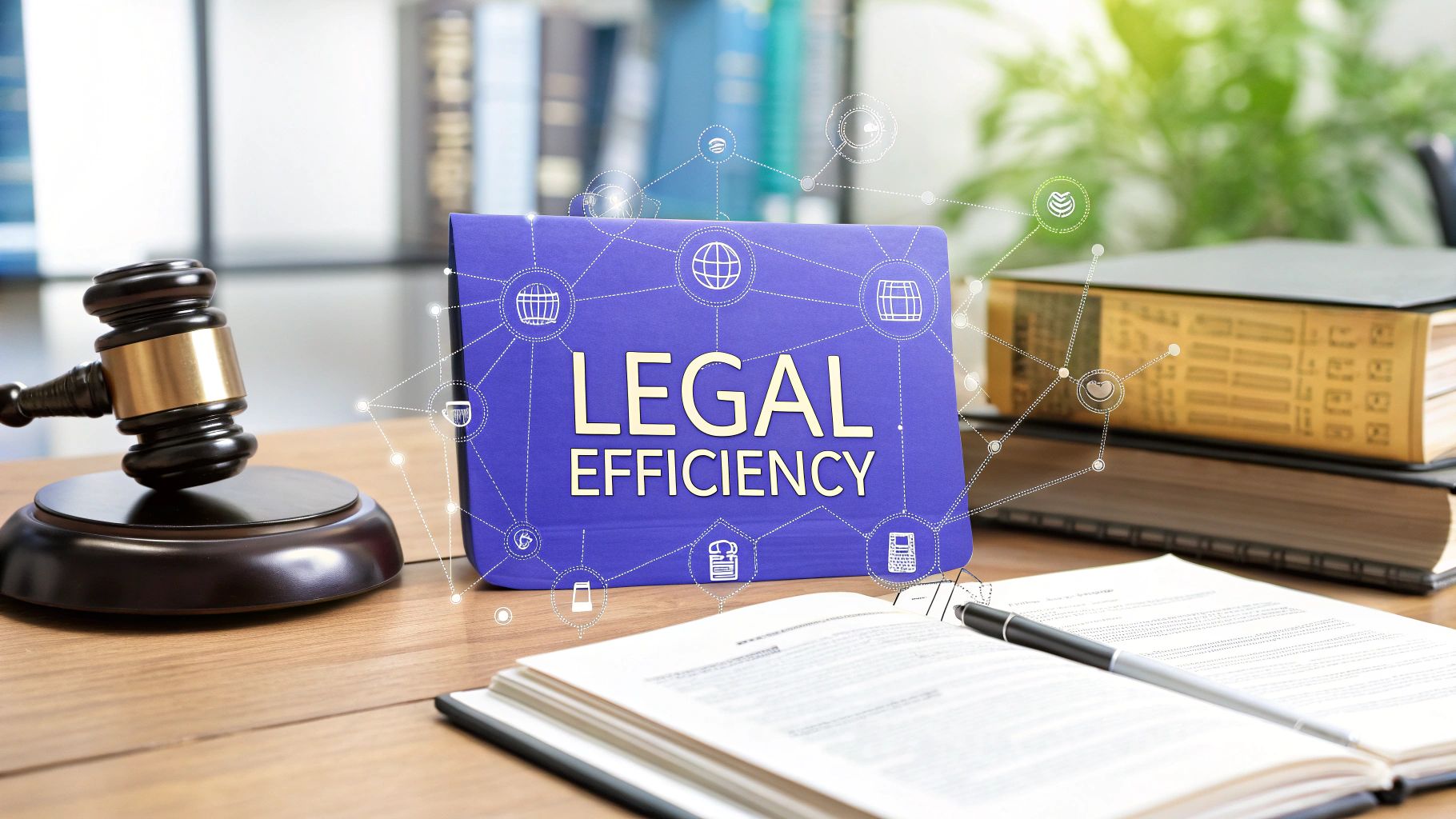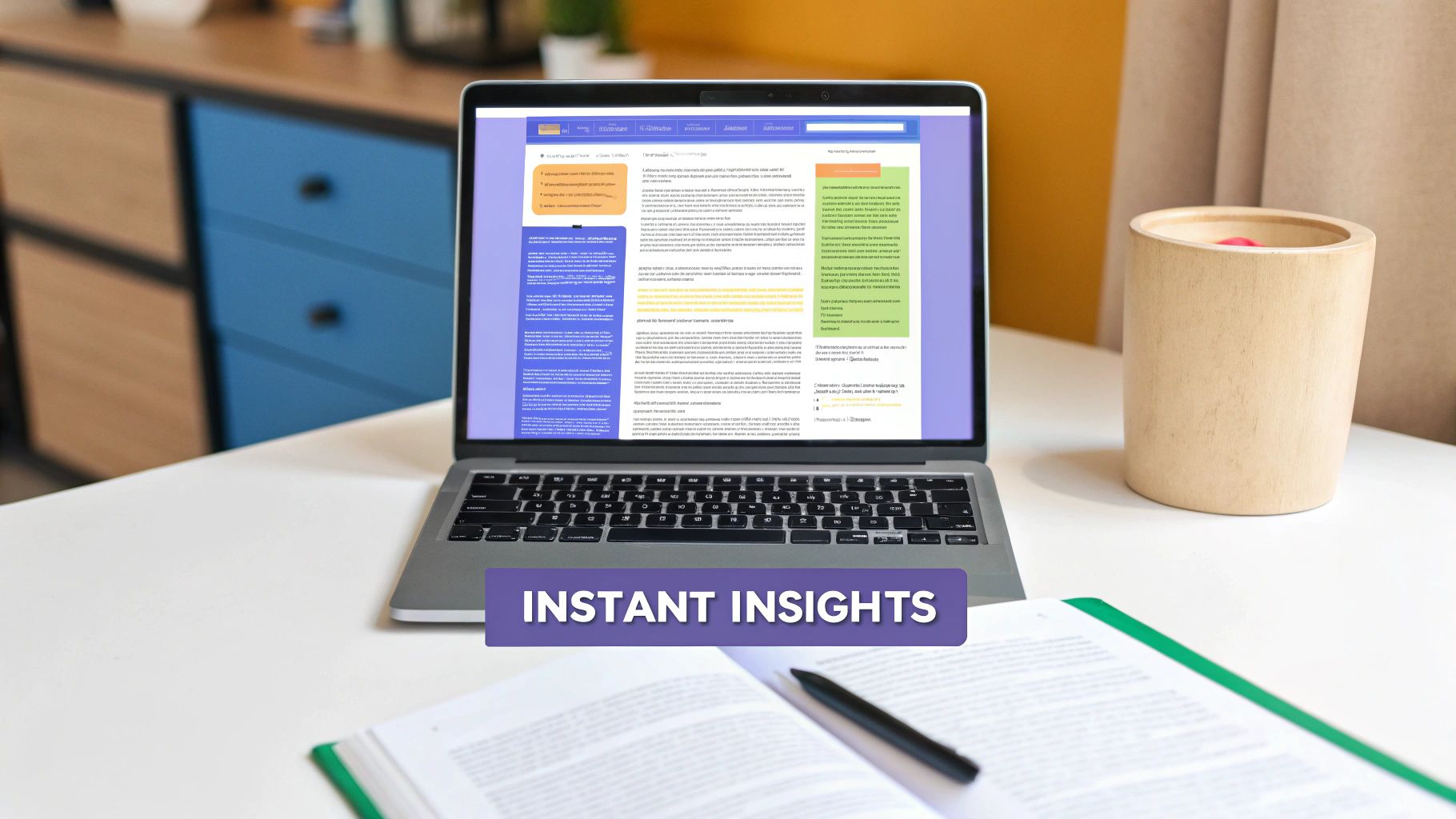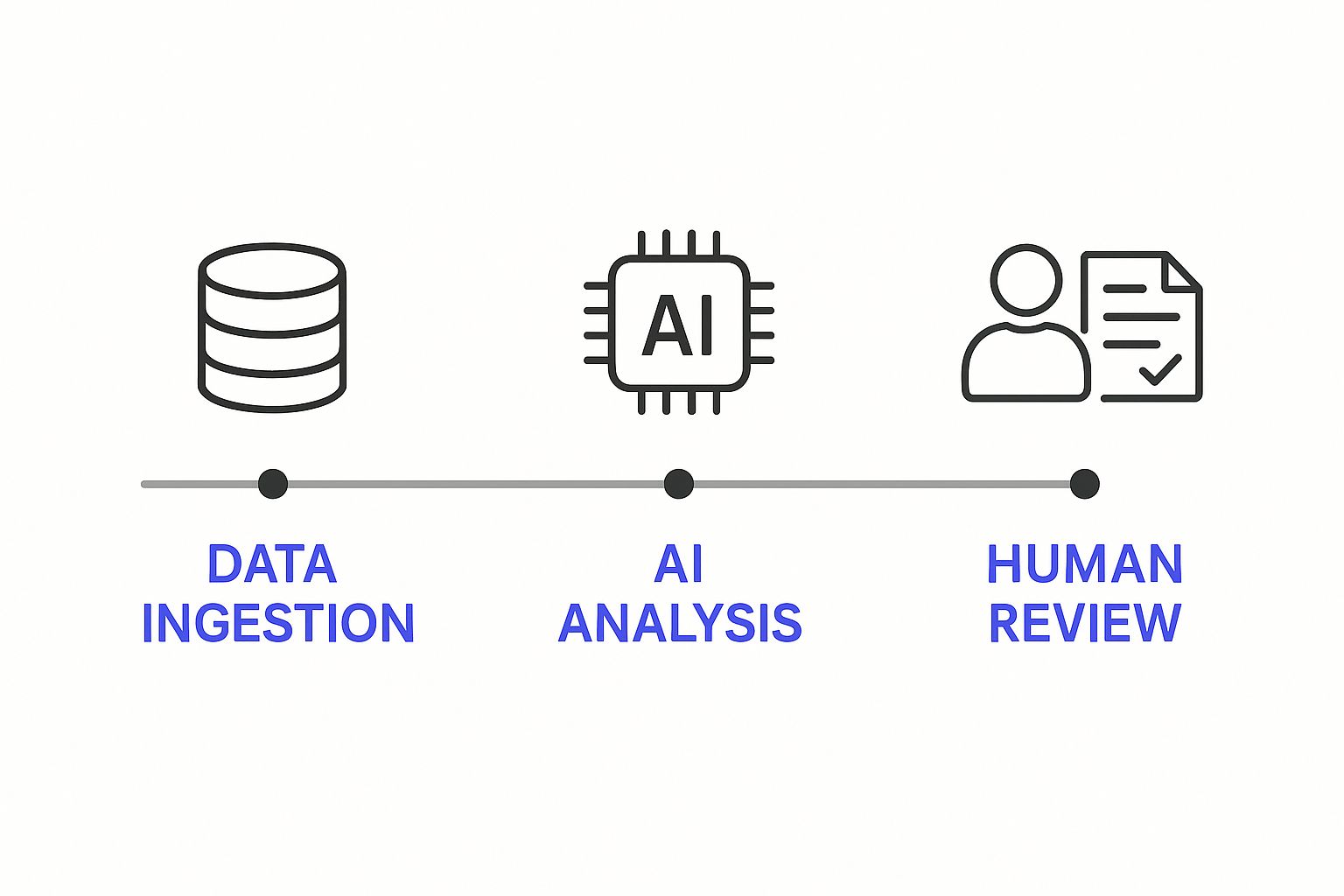
The Revolution Behind Automated Contract Analysis
Automated contract analysis is significantly changing how legal teams work, bringing contract workflows into the modern era. For decades, contract review was a slow, manual process. Now, machine learning and natural language processing (NLP) work together to analyze contracts with remarkable speed and accuracy. This allows legal professionals to concentrate on more strategic tasks, leaving the initial review to intelligent software.
Understanding the Technology
How does automated contract analysis work? Think of NLP as the technology that lets computers understand human language. Like a human reviewer scanning for key clauses, NLP breaks down the document, identifying and categorizing its parts. Machine learning then enables the system to learn from large amounts of data. By analyzing thousands of contracts, the system learns to identify patterns, predict risks, and even suggest better wording. This reduces human error and provides a more precise assessment of each contract.
Practical Applications of Automated Contract Analysis
This technology has many applications. Automated contract analysis systems can extract important clauses, such as payment terms or termination rights, much faster than a human. These systems can also flag potential risks, like unfavorable liability clauses, that a manual reviewer might miss. This proactive risk management helps organizations avoid expensive disputes and improves their negotiating position. The technology can also track obligations and deadlines, ensuring compliance and preventing breaches.
The market recognizes the value of this change. The global contract management software market, which includes automated contract analysis tools, was valued at $2.8 billion in 2024. It's expected to grow at a 10.6% CAGR through 2034, driven by the demand for reduced risk and automated workflows. Discover more insights about the contract management software market
Transforming Contract Review From Bottleneck to Advantage
Automated contract analysis isn't just about speed and efficiency; it’s about making contract review a strategic asset. By automating routine tasks, legal teams can dedicate more time and resources to strategic projects. This allows legal professionals to contribute more effectively to business goals, providing valuable insights and guidance for better results. It’s a real shift in the legal field, leading to more efficient, effective, and insightful contract management.
Measurable Benefits That Justify Investment Today

Automated contract analysis is becoming increasingly important for businesses looking to improve efficiency and accuracy in their contract management processes. It offers tangible benefits that make it a worthwhile investment for legal teams. Let's explore the quantifiable advantages of adopting this technology.
Time Savings and Increased Efficiency
Automated contract analysis dramatically reduces review time. Tasks that previously required days of manual labor can now be completed in mere minutes. This efficiency boost allows legal professionals to dedicate more time to strategic work like negotiation and strategy development.
Imagine a lawyer reviewing hundreds of contracts for a merger. Manually, this process could take weeks. Automated analysis, however, can pinpoint key clauses and risks in hours, significantly speeding up the entire process. This accelerated pace also contributes to quicker deal closures and rapid responses to urgent legal matters.
Improved Accuracy and Risk Mitigation
Automated systems not only increase speed but also significantly enhance accuracy. Studies indicate a 35-65% improvement in accuracy with automated contract analysis compared to manual review. This translates to fewer overlooked clauses and a lower risk of errors.
These systems consistently identify potential risks, such as unfavorable liability clauses or missing provisions, which human reviewers might miss. This proactive risk management approach allows legal teams to address potential issues early on, preventing them from escalating into costly disputes.
Optimized Resource Allocation and Cost Savings
Automated contract analysis optimizes resource allocation by minimizing the need for manual review. This enables firms to reallocate attorney time to more strategic initiatives, resulting in substantial cost savings. Legal Document Automation is a key factor driving the increasing adoption of this technology.
Instead of spending countless hours on standard contract reviews, legal professionals can concentrate on complex negotiations, strategic planning, and client interaction. This shift improves the bottom line and enhances job satisfaction, allowing lawyers to engage in more stimulating aspects of their work.
Data-Driven Insights and Stronger Negotiation
Automated analysis provides valuable data-driven insights into contract trends and patterns. This data empowers legal teams with the knowledge to improve their negotiating positions.
By analyzing large contract datasets, these systems can identify market standards, benchmark pricing, and highlight potential areas for improvement. This data-driven approach facilitates more informed decisions during negotiations, leading to favorable outcomes for the organization. These insights also inform the development of best practices and refine contract templates, leading to a cycle of continuous improvement in contract management.
To illustrate the quantifiable benefits, let's consider a direct comparison:
The following table summarizes the potential return on investment (ROI) when transitioning from manual to automated contract analysis:
ROI Comparison: Manual vs. Automated Contract Analysis
This table compares key performance metrics between traditional manual contract analysis and modern automated solutions.
| Performance Metric | Manual Process | Automated Analysis | Improvement % |
|---|---|---|---|
| Review Time (per contract) | 2-3 days | 1-2 hours | 90-95% |
| Accuracy | 70-80% | 95-99% | 21-41% |
| Errors Found | Low-Medium | High | >50% |
| Cost per Review | $500-$1000 | $50-$100 | 90-95% |
| Time to Deal Closure | 4-6 weeks | 1-2 weeks | 50-75% |
As the table demonstrates, automated contract analysis leads to significant improvements across key metrics. The reduction in review time, coupled with increased accuracy and cost savings, makes a compelling case for its adoption. Faster deal closures further enhance the ROI, making automated contract analysis a strategic investment for modern legal teams.
Leading Innovations in AI-Powered Contract Tools

The field of automated contract analysis is constantly changing. It's essential to separate real progress from marketing hype. This means looking past the buzz and focusing on core functionalities that deliver actual value.
Contextual Understanding and Pattern Recognition
A major innovation is contextual understanding. Advanced AI tools are now able to understand the nuances of contract language, moving beyond basic keyword searches. They interpret meaning and intent, much like experienced legal professionals. This allows these tools to grasp the meaning behind complex clauses, not just individual words.
Pattern recognition is another key advancement. These tools can analyze large volumes of documents, identifying recurring risk patterns that human reviewers might miss. Imagine an AI identifying a clause repeated across contracts that often leads to disagreements. This allows businesses to address such weaknesses proactively.
Predictive Analytics and Self-Learning Systems
Predictive analytics is another significant development. This technology allows AI to forecast problems before they occur. Think about predicting the chance of a contract breach based on past data and current market trends. This proactive method empowers better decision-making and risk mitigation.
Many contract analysis tools now utilize self-learning systems. These systems continuously improve their accuracy through user input and ongoing data exposure. The tool adapts to the specific requirements of each business, becoming more efficient over time. Automated contract analysis offers quantifiable advantages, especially when considering how well-crafted employment contracts can protect, save, and make your business money.
Specialized Solutions and Integration Capabilities
The creation of specialized solutions for specific industries is also a notable trend. These tools offer targeted functionality. For example, a tool designed for healthcare might have built-in HIPAA compliance checks. This focused method maximizes practical value.
Advanced integration capabilities allow these systems to seamlessly connect with other business intelligence platforms like Tableau or Power BI. Contract data can then be used to shape wider strategies, leading to more data-driven decisions. This adoption of AI-powered solutions is growing. Projections show that by 2025, automated contract tracking with AI for drafting, analysis, and compliance will be the dominant approach. Learn more about this. As AI evolves, identifying genuinely beneficial innovations becomes crucial. Focusing on these key capabilities will allow businesses to truly benefit from automated contract analysis.
Implementation Blueprint: From Selection to Success

Successfully implementing automated contract analysis takes careful planning and execution. This section offers a practical roadmap, incorporating lessons from real-world implementations – both the successes and the challenges. This blueprint helps you avoid common pitfalls and maximize your return on investment.
Needs Assessment and Vendor Selection
The first step is a thorough needs assessment. This means identifying your organization's specific contract management pain points. Are slow review times, high error rates, or difficulty tracking obligations causing problems? For example, a company with many sales contracts might prioritize automation for reviewing standard clauses. A legal department handling complex mergers and acquisitions, however, may prioritize AI-powered due diligence. This assessment guides your vendor selection process.
Choosing the right vendor means looking beyond marketing. Focus on vendors who can demonstrably meet your needs. Pilot programs are crucial for evaluating different solutions like Kira Systems or LexCheck. Pilots let you experience the software firsthand and assess its fit with your workflows.
Data Migration and Workflow Integration
Data migration is a critical implementation aspect. This often involves moving existing contracts into the new system. Effective data migration strategies are key for a smooth transition and minimal disruption. The chosen solution should integrate seamlessly with your current workflows. If your team relies heavily on Microsoft Word, a tool with a Word plugin will make adoption easier.
User Training and KPI Establishment
User training is vital for success. Training should address user concerns and highlight the system's benefits. To overcome resistance to change, emphasize how automated analysis empowers legal teams to focus on strategic work.
Establishing key performance indicators (KPIs) lets you measure the implementation's impact. Track metrics like review time reduction, accuracy improvement, and cost savings. These KPIs demonstrate the value of automated contract analysis and offer insights for ongoing optimization.
Implementation Timeline and Key Milestones
The timeline below visually represents a typical implementation process, outlining key milestones and their significance.
Implementation Timeline & Key Milestones
| Phase | Key Activities | Duration | Success Indicators |
|---|---|---|---|
| Needs Assessment and Vendor Selection | Identify needs, evaluate vendors, select vendor for pilot | 1-2 months | Completed needs assessment, selected vendor |
| Pilot Program and Refinement | Run pilot program, gather user feedback, refine system configuration | 2-3 months | Successful pilot completion, documented benefits |
| System Implementation and Data Migration | Deploy system, migrate existing contracts, configure integrations | 3-4 months | Completed data migration, system launch |
| User Training and Integration | Train users, integrate with other systems, refine workflows | 1-2 months | High user adoption, successful system integration |
| Ongoing Monitoring and Optimization | Monitor KPIs, identify areas for improvement, refine system configuration | Ongoing | Consistent KPI improvement, maximized system value |
This structured approach ensures a measured and successful implementation. Tracking these milestones helps maintain progress and achieve desired outcomes.
This implementation blueprint provides a flexible framework. You'll need to adapt it to your organization's specific needs and complexity. By following these guidelines, you can smoothly integrate automated contract analysis and realize its full potential.
Industry-Specific Applications That Actually Work

Automated contract analysis isn't a one-size-fits-all solution. Its applications are diverse across various industries, each presenting unique opportunities and obstacles. Let's explore how different sectors are leveraging this technology for tangible improvements.
Financial Services: Managing Risk and Compliance
Financial institutions manage a massive volume of agreements, each bound by specific regulatory requirements. Automated contract analysis helps manage this complexity. It reduces risk and strengthens compliance efforts.
For example, banks use these tools to examine loan agreements. This helps flag potential defaults and ensure adherence to lending regulations. This proactive approach minimizes financial exposure and helps maintain regulatory compliance. Some institutions have even reported a 40% reduction in risk exposure after implementing automated contract analysis.
Healthcare: Ensuring HIPAA Compliance and Streamlining Vendor Management
Healthcare providers operate under stringent compliance standards, particularly concerning patient data privacy under HIPAA. Automated contract analysis helps ensure adherence to these regulations. It identifies clauses related to data security and patient confidentiality.
Furthermore, these tools streamline vendor management. They quickly analyze contracts with suppliers, ensuring terms align with HIPAA guidelines and internal policies. This enhanced oversight reduces the risk of costly fines and reputational damage.
Manufacturing: Optimizing Supply Chain Contracts and Preventing Disruptions
Manufacturing companies rely heavily on complex supply chain contracts. Automated contract analysis optimizes these agreements by pinpointing potential bottlenecks and risks. This proactive approach helps avoid costly disruptions. It also ensures the timely delivery of goods.
For example, analyzing supplier contracts allows manufacturers to identify and address potential delivery delays or quality issues before they escalate.
Legal: Enhancing Due Diligence and Accelerating Deal Closures
Law firms utilize automated contract analysis to perform due diligence, saving countless hours of manual review. These tools quickly identify key clauses, potential risks, and areas needing further investigation. This increased efficiency speeds up deal closures and improves client service.
Moreover, it allows legal professionals to focus on higher-value tasks, such as negotiation and strategy. This allows them to fully utilize their expertise. This area is expected to grow, with automated contract tracking impacting sectors like legal, finance, and procurement between 2025 and 2032. AI systems are projected to provide real-time risk assessments and automated negotiation support. Find more detailed statistics here.
These industry examples highlight the practical benefits of automated contract analysis. Organizations can adapt the technology to their specific requirements. This leads to measurable improvements in efficiency, risk management, and compliance. Whether your organization is in finance, healthcare, manufacturing, or law, tools like Legal Document Simplifier offer solutions to transform contract management processes. By implementing these solutions, organizations gain a competitive advantage in the dynamic business world.
Tackling the Real Challenges in Implementation
Implementing automated contract analysis offers significant advantages, but it also comes with its own set of challenges. Proactive planning is key for successful integration. This involves understanding potential obstacles and creating strategies to overcome them.
Data Quality and Legacy Documents
A major hurdle is data quality. Automated contract analysis needs clean, consistent data to function effectively. However, many organizations face inconsistent formatting and missing information in their current contracts. This is particularly true for legacy documents, which may be stored across various formats, including physical copies. A practical solution is to establish a clear data migration plan. This could involve digitizing paper contracts and standardizing formats before uploading them into a system like Legal Document Simplifier. Its ability to process diverse file types can simplify this process.
Stakeholder Resistance and Change Management
Another challenge is stakeholder resistance. Some legal professionals, used to manual reviews, may be hesitant about AI's capabilities. IT departments, focused on system integration and data security, might also be resistant. Addressing these concerns requires open communication and showcasing the system's benefits. Emphasizing time savings, improved accuracy, and reduced risk can ease anxieties and encourage adoption. Positioning automated contract analysis as a tool that empowers legal teams, not replaces them, is crucial for building acceptance.
Integration Challenges and Human Oversight
Integrating automated contract analysis with current systems can be complicated. Ensuring a smooth data flow between platforms is essential. This requires careful preparation and teamwork with IT. Furthermore, while automation is valuable, it shouldn't eliminate human oversight. Attorneys should maintain final approval and review, especially for complex or unusual contracts. Legal Document Simplifier's user-friendly interface and integration options can smooth this transition, allowing for seamless incorporation into existing workflows.
Security and Confidentiality Concerns
Data security and confidentiality are paramount. Contract data is sensitive and requires robust security measures. Selecting a secure platform with proper access controls is vital. Addressing security concerns from IT and ensuring compliance with relevant regulations, such as GDPR, builds trust and facilitates implementation. Legal Document Simplifier prioritizes data privacy and security, offering peace of mind for organizations managing sensitive information.
By proactively addressing these challenges, organizations can ensure successful automated contract analysis implementation. This involves recognizing potential roadblocks, communicating clearly with stakeholders, and selecting a platform that emphasizes data quality, integration, and security. Doing so allows businesses to unlock the full potential of this technology.
Future Capabilities That Will Reshape Legal Work
Automated contract analysis is already changing how legal practices operate, but the future holds even greater potential. Emerging capabilities promise to fundamentally alter how organizations handle agreements, creating exciting new opportunities for legal professionals.
Advanced Predictive Analytics: Anticipating Disputes
Current automated contract analysis tools are excellent at identifying existing risks. Future systems, however, will utilize advanced predictive analytics to forecast potential disputes before they occur. By examining large datasets of contract-related litigation and market trends, these systems will be able to assess the probability of future breaches or disagreements.
This will empower legal teams to proactively address vulnerabilities and mitigate potential problems, transitioning from a reactive approach to proactive risk management. For example, envision a system that predicts the likelihood of a supplier failing to meet its obligations based on their past performance and current economic conditions. This foresight would allow businesses to adjust contracts or identify alternative suppliers, preventing costly disruptions.
Natural Language Generation: Transforming Contract Drafting
While automated analysis focuses on interpreting existing contracts, natural language generation (NLG) will reshape contract drafting. Natural language generation can produce initial contract drafts based on pre-defined criteria and legal precedents. This not only speeds up the drafting process, but also ensures consistency and minimizes errors.
Importantly, NLG does not eliminate the lawyer's role. Instead, it allows legal professionals to focus their time on refining and negotiating important terms, rather than drafting boilerplate language. This enables them to apply their expertise where it truly matters, adding value through strategic guidance.
Blockchain Integration: Revolutionizing Execution and Compliance
Blockchain technology will revolutionize contract execution and compliance monitoring. By storing agreements on a secure, permanent ledger, blockchain guarantees transparency and simplifies verification. This removes the need for tedious manual tracking and lessens the risk of fraud.
Moreover, smart contracts, self-executing contracts with terms written into the blockchain’s code, automate compliance. For example, payment could be automatically released upon verification of delivery, streamlining transactions and reducing delays.
New Roles and Opportunities for Legal Professionals
These advancements will create exciting new roles and opportunities for legal professionals. Rather than concentrating on routine tasks, lawyers will assume more strategic positions, such as:
- Contract Strategist: Designing and implementing optimal contract strategies that align with business objectives.
- Legal Technologist: Managing and optimizing automated contract analysis systems.
- Data Analyst: Interpreting contract data to identify trends and provide valuable insights.
These roles emphasize more complex, higher-value work, making the legal profession more engaging and impactful. By automating routine tasks, automated contract analysis allows legal professionals to dedicate their attention to their core strength: providing strategic legal counsel.
Visit Legal Document Simplifier to explore how AI-powered solutions can transform your legal operations.
Article created using Outrank